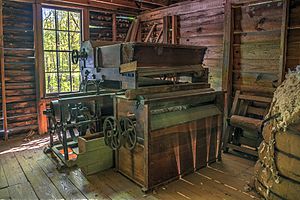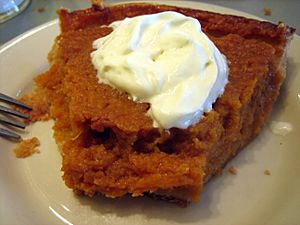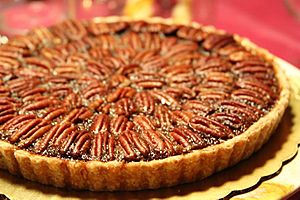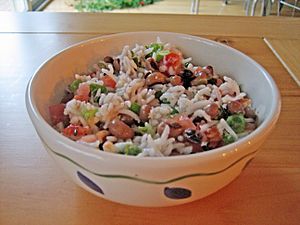Black Southerners facts for kids

A family of African American slaves on a plantation in South Carolina.
|
|
| Total population | |
|---|---|
| 11,054,127 (1980) | |
| 20,595,194 (2019) | |
| Regions with significant populations | |
| 1,156,497 | |
| 3,996,697 | |
| 1,554,297 | |
| 1,441,530 | |
| 1,364,474 | |
| 2,424,132 | |
| 1,820,891 | |
| 1,228,973 | |
| 3,772,874 | |
| 1,946,932 | |
| 3,908,287 | |
| 320,704 | |
| 502,913 | |
| 424,716 | |
| 237,780 | |
| 307,819 | |
| 64,285 | |
| Languages | |
| Southern American English, African American English, Gullah, Afro-Seminole Creole, Louisiana Creole, African-American Vernacular English, New Orleans English, Louisiana French | |
| Religion | |
| Protestantism, Islam, Roman Catholicism, Atheism, Louisiana Voodoo | |
| Related ethnic groups | |
| White Southerners, African Americans, Louisiana Creole people, Gullah, Melungeon, Black Seminoles, Redbones, Creoles of color | |
Black Southerners are African Americans who live in the Southern United States. This region has the largest black population in the United States.
From 1916 to 1970, about 6 million Black people moved from the South to cities in the North and West. This was called the Great Migration. Even so, most Black people still live in the Southern states. Since the 1970s, many Black Americans have moved back to the South. This is known as the New Great Migration. These people often have more education and settle in cities.
Black Southerners have greatly shaped the culture of the South. They influenced Christianity, foods, art, and music. Music styles like spirituals, blues, jazz, and rock and roll all have roots in Black Southern culture.
African slaves were brought to the South during the slave trade. Slavery was mainly in the American South. By 1850, about 3.2 million African slaves worked in the United States. Many worked in cotton fields. Before the Civil War, over 4 million black slaves worked in the South. Virginia had the most slaves, followed by Georgia, Mississippi, Alabama, and South Carolina. Today, large Black communities live in Southern cities like Houston, Memphis, New Orleans, Dallas, and Atlanta.
Black Southerners often feel a stronger connection to Southern identity than White Southerners.
Contents
History of Black Southerners
- Further information: History of the Southern United States
Early Beginnings
The story of Africans in the South began in 1619. A ship carrying 350 black Africans from the Kingdom of Ndongo in Angola was stopped by pirates. The pirates took 60 of the healthiest people. They hoped to sell them in the English colony of Jamestown.
The settlers in Jamestown bought 32 of these people (17 men and 15 women). They hoped that slave labor would help their colony grow. These enslaved people and their children worked in Jamestown until 1705. Between 1619 and the start of the American Revolutionary War in 1775, hundreds of thousands of black Africans were sold into slavery. They were brought to the Thirteen Colonies.
Role in the Revolutionary War
African Americans played a big part in America's fight for independence. They had faced much unfair treatment. They saw the war as a chance to gain freedom from slavery. Black people fought for the side they thought would help them become free.
About 20,000 African Americans joined the British side. The British promised freedom to enslaved people who fought for them. These were called Black Loyalists. Around 9,000 African Americans became Black Patriots. Many enslaved men who fought in the war did gain their freedom. However, some owners did not keep their promises.
Both the Continental Navy (American) and Royal Navy (British) allowed African Americans to join. Even Southern colonies, who worried about arming enslaved people for the army, used Black men on ships. Some African Americans became captains in state navies, especially in South Carolina.
The British army worried that armed Black men might start uprisings. To calm Southern plantation owners, the British used African Americans as laborers, skilled workers, and spies. Lord Dunmore, the governor of Virginia, promised freedom to enslaved people who belonged to rebels and fought for him. In November 1775, he announced this. By December 1775, 300 enslaved men wore British military uniforms. Their uniforms had "Liberty to Slaves" sewn on them. These men were called "Lord Dunmore's Ethiopian Regiment."
Later in the war, when the British needed more soldiers, they used African Americans to fight in the South. In cities like Savannah, Georgia, Augusta, Georgia, and Charleston, South Carolina, Black Loyalist soldiers helped the British defend against attacks.
George Washington worried that the British would arm Black men faster. He suggested a policy to punish enslaved people who tried to join the British. However, he also ordered recruiters to re-enlist free Black men who had already served. He feared these soldiers might switch to the British side.
In 1776, the Continental Congress agreed to re-enlist free Black men. Patriots in South Carolina and Georgia did not want to enlist enslaved men as soldiers. Black soldiers from Northern units often fought in Southern battles. In some Southern states, enslaved Black men fought for their masters in the Patriot army.
From Revolution to Civil War
After the Revolutionary War, Black Patriots found few rewards. The military became much smaller. Southern states banned all enslaved men from their militias. North Carolina allowed free people of color to serve in their militias until the 1830s. In 1792, the United States Congress officially said only "free able-bodied white male citizens" could serve in the military.
In 1789, when the Constitution was approved, free Black men could vote in five of the thirteen states. This showed they were seen as citizens.
Many slaveholders, especially in the Upper South, were inspired by the idea of freedom. They freed the people they had enslaved. Also, Methodist, Baptist, and Quaker preachers encouraged freeing slaves. The number of free Black people in the Upper South grew a lot. It went from less than 1% to over 10% of all Black people. More than half of all free Black people in the U.S. lived in the Upper South. In Delaware, almost 75% of Black people were free by 1810. This also happened because the economy changed. Many farmers switched from tobacco, which needed a lot of labor, to other crops.
After this time, fewer enslaved people were freed. In 1793, Eli Whitney invented the cotton gin. This machine made it much easier to clean cotton. It used a wire screen and hooks to pull cotton through. Brushes then removed the loose cotton.

The cotton gin made growing short-staple cotton very profitable. The Deep South became a major cotton-growing area. This greatly increased the demand for slave labor. More than one million enslaved people were moved to the Deep South through the domestic slave trade.
Before the cotton gin, it took a slave about ten hours to clean one pound of cotton. With the gin, two or three slaves could produce about fifty pounds of cotton in one day. Cities like New Orleans, Mobile, Charleston, and Galveston became important shipping ports for cotton.
Cotton production grew hugely in the South. It went from 750,000 bales in 1830 to 2.85 million bales in 1850. The South became even more dependent on slave plantations. Agriculture became the biggest part of its economy. The number of slaves also increased. It rose from about 700,000 in 1790 to about 3.2 million in 1850. The cotton gin reversed the economic decline in the South from the late 1700s. It "transformed cotton as a crop and the American South into the globe's first agricultural powerhouse."
Because of its effect on slavery, the cotton gin is often seen as one of the indirect causes of the American Civil War. It made the South's economy rely on plantations. It also encouraged the growth of the textile industry in other places, like the North.
Civil War and Jim Crow Laws
During the Civil War, runaway slaves from the South joined the Union army. In the Confederacy, both free and enslaved Black people did manual labor. There was a big debate about whether to arm them. Most newspapers, politicians, and army leaders were against arming Black people.
However, as the war became desperate, the Confederacy changed its policy. In March 1865, a small program tried to recruit and train Black soldiers. But not many were ever recruited, and none saw combat.
The Civil War led to important changes. The 13th Amendment ended slavery across the country. The 14th Amendment said that all people born in the U.S. are American citizens. The 15th Amendment gave citizens the right to vote, no matter their "race, color, or previous condition of servitude."
Reconstruction was the process of making newly freed slaves citizens with civil rights. This angered many white Southerners. They did not want Black people to have citizenship or the right to vote. They feared "Negro supremacy" (Black majority rule). In reality, Black people never controlled the South politically.
For about 100 years after the Civil War, Black Americans, especially in the South, faced unfair treatment. This included segregation and violence. Jim Crow laws were passed in the late 1800s and early 1900s. These laws required racial segregation in states that had slavery. By 1910, Jim Crow laws were fully in place. They brought back white supremacy. They also took away the citizenship and voting rights that Black people had worked hard to gain.
These laws were based on "separate but equal," but this was not true. Black people and white people were separated in public places like schools, bathrooms, and transportation. Black people usually got worse facilities. Segregation affected where people were born, which schools children could attend, and even where people were buried. There were different legal rules for Black and white people. The Ku Klux Klan often worked with law enforcement to use violence and intimidation against Black people.
Great Migration and Civil Rights Movement

In the 20th century, two big events changed the lives of Black Southerners. These were the Great Migration and the Civil Rights Movement.
The first Great Migration started during World War I and lasted until 1940. The second wave happened during World War II and the economic boom after the war, lasting until 1970. During these migrations, five million Black people left the South. They moved to Northern and Western states to find work. They also wanted to escape segregation, violence, and not being able to vote in the South.
However, Black migrants still faced discrimination in the North and West. They were seen as job competitors. People blamed them for lowering property values. Despite this, conditions in the North and West were better. Black people there could vote, send their children to better schools, and earn more money.
Jimmie Lewis Franklin noted that many Black people stayed in the South. This was not because they accepted racism. It was because they wanted to stay in their established homes.
The migration also helped the growing civil rights movement. This movement was active across the U.S., but it focused on ending Jim Crow laws and unfair voting rules in the South. A key part of the movement was nonviolent resistance. Groups were formed around this idea. Nonviolence was often based on religious beliefs and the idea of treating everyone with love. Leaders like Martin Luther King Jr. and James Bevel were inspired by Gandhi.
School segregation was declared illegal in 1954. This happened with the Supreme Court ruling of Brown vs. Board of Education. This ruling overturned the "separate but equal" idea from the 1896 case of Plessy vs. Ferguson. The Court said that "separate but equal" was not true in reality. In 1954, segregation was still a big part of Southern life. It was everywhere: restaurants, restrooms, and water fountains.
James Meredith was the first African American student to attend the University of Mississippi. In 1962, the governor of Mississippi tried to stop him. A race riot happened when Meredith arrived. President John F. Kennedy had to send the National Guard to Oxford, Mississippi. Two people were killed and 200 were injured. The next year, George Wallace, the governor of Alabama, stood in the doorway of the University of Alabama. He tried to stop two Black students, James Hood and Vivian Malone, from enrolling. He eventually stepped aside.
Most major events in the Civil Rights Movement happened in the South. These include the Montgomery bus boycott (1955–1956), the Mississippi Freedom Summer (1964), and the Selma to Montgomery marches (1965). In 1955, the Montgomery Improvement Association was formed after Rosa Parks was arrested for sitting in the white section of a bus. Martin Luther King Jr. became its president. The Association organized carpooling and prayer groups. In 1956, the Supreme Court ruled bus segregation illegal. The Montgomery bus boycott made King a national leader. He emphasized nonviolence.
The Montgomery bus boycott helped create groups focused on nonviolence. These included the Southern Christian Leadership Conference and the Student Nonviolent Coordinating Committee. Important writings from the movement came from Black Southerners, like King's famous 1963 "Letter from Birmingham Jail". Many civil rights landmarks are in the South. The Martin Luther King Jr. National Historical Park in Atlanta has a museum about the movement. It also includes King's boyhood home and Ebenezer Baptist Church. The King Center for Nonviolent Social Change, where Martin and Coretta Scott King are buried, is also there.
New Great Migration
The Civil Rights Movement of the 1950s and 1960s ended Jim Crow laws. Now, a third migration is happening. African Americans from the North and West are moving back to the South in large numbers. While racial issues still exist, the South is ahead of other parts of the country in many areas of integration.
A 2003 report found that Virginia Beach, Charlotte, Houston, Nashville-Davidson, and Jacksonville were among the most integrated large cities. Southern states also tend to have smaller differences in incarceration rates between Black and white people.
Culture of Black Southerners
Music
Blues music started from "sorrow songs" that enslaved people would sing. Blues began in the Deep South, especially in cities like Memphis and New Orleans. Blues often features one singer with an instrument, usually a guitar. The songs express feelings about love, betrayal, poverty, and tough lives.
Jazz music started in New Orleans in the 1910s. Black and white musicians mixed European and African music styles. Jazz was a different kind of Blues music. Blues was seen as lower class, while jazz was more stylish. Aretha Franklin and Ray Charles were famous jazz musicians.
In the 1960s, funk music appeared. Funk music brings soul and energy. It is known for using the electric bass guitar to create long, danceable songs. James Brown was a famous funk musician. Michael Jackson combined funk and soul music to create popular music.
Rap music grew from the feelings of the civil rights movement. Soul music was a big inspiration for rap. Rap and hip-hop music are often used to mean the same thing. However, hip-hop covers more topics and has a different energy. In the 1990s, Gangsta rap emerged. There were rap rivalries between the East and West Coasts. In the South, many Black people perform and listen to Southern hip hop. Southern cities with their own hip hop scenes include Houston, Atlanta, New Orleans, Memphis, and Miami. Lil Wayne, from New Orleans, is a famous Southern hip hop musician. He has won Grammy Awards and sold millions of albums. Other notable Southern hip hop musicians include Lil Jon, T.I., Flo Rida, Rich Boy, Rick Ross, and Young Jeezy.
In the 20th century, gospel music came from Black and white people. They created soulful music with deep energy that also includes dance. This music mixed Protestant hymns and African styles. Black gospel musicians started their own trends with duos and choirs. They competed worldwide in singing groups. Eventually, white and Black gospel groups combined, but they often remained distinct.
R&B is popular among African Americans in the South. New Orleans rhythm and blues is often performed by Black musicians from New Orleans. Beyoncé is a famous Black R&B singer from the South. She often honors her Southern culture in her music and videos.
Religion
After the Civil War, there was a big change in religion in the South. Black people mostly joined the African Methodist Episcopal Church and the National Baptist Convention. They were rarely found in historically white churches. By 1906, the National Baptist Convention had over 61% of the Black Christian community. From 1890 to 1906, the number of Black churchgoers grew by one million.
Reverend Martin Luther King Jr. was a very important African-American minister in the South. He led a Baptist church in Atlanta.
Many other Christian groups and religions have come to the South with new migrants. There has been a lot of growth in different religions in the South. Catholic, Jewish, Hindu, and Buddhist religions have been introduced in large Southern cities. In 1999, more than 1 in 5 people said they belonged to a religion other than a Protestant group. African Americans made up 39% of these people.
In 2000, the city of Atlanta had 10,000 Buddhists, 12,000 Hindus, and 30,000 Muslims.
In Louisiana, some Black Southerners practice Louisiana Voodoo. Enslaved people brought their Voodoo religion to Louisiana and Haiti from Benin.
Food
- Further information: Soul food and Cuisine of the Southern United States
The South is famous for many foods. Many of these foods have African American influences.
George Washington Carver, a botanist, made many discoveries about the peanut. He showed all the different things that could be made from a peanut.
Sweet:
Savory:
- Cornbread
- Pulled pork
- Grits
- Jambalaya (Louisiana)
- Deviled eggs
- Fried Chicken
- Gumbo (Louisiana)
- Hoppin' John (South Carolina)
Jobs and Professions
The job market for African Americans has changed a lot in the last fifty years. Before, almost all African Americans were poor. The poverty rate has gone down a lot since then. Today, more than 40% of African Americans consider themselves middle class.
They used to have low-paying manual jobs. These included sharecroppers or other jobs that white people did not want. Most African American women worked as servants and were paid even less than men. Fifty years ago, 6 out of 10 African American women worked as servants.
Today, African Americans are one of the fastest-growing groups of business owners in the U.S. Over half of the Black population in America works in white-collar jobs (professional office jobs). The income gap between Black and white people has been cut by about a third. While a gap still exists, two-parent Black families earn 13% less than two-parent white families.
Black Suburbs
Since the second Great Migration ended in 1970, many Black people have moved back to the South. This is partly because race relations have improved and the economy in the South is better. Main destinations include Texas, Georgia, North Carolina, Maryland, Virginia, Tennessee, and Florida.
African Americans started moving to the suburbs to find safer and more comfortable homes. There is a common idea that most African Americans live in poor city areas. But actually, over 33% live in the suburbs. While both white and Black families live in suburbs, the neighborhoods often remain separate. Many middle-class African American families live in all-Black suburbs. The African American middle class continues to grow. More than 40% of the Black middle-class population owns a home.





